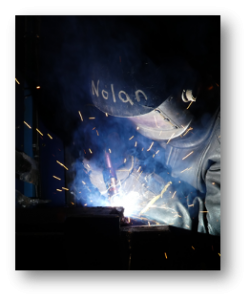When you talk to a Grade 12 student, it is not unusual to come across feelings of anxiousness and uncertainty for their future. School District No. 73 (SD73) strives to help build smoother transitions into post-secondary and to build student aspirations.
Creating opportunities for students to explore career options and build their aspirations is approached in a multitude of frameworks at School District No. 73 (SD73). Students have numerous career exploration opportunities with community partnerships that can lead to dual credit career programs and early entrance into post-secondary. Students also partake in a robust implementation of Career Education through the K-12 system with key district supports such as Career Talks, Discover Days and Career Experiences.
Based on our experiences delivering comprehensive career education to students, I have highlighted a few ways that secondary schools can connect students to career-related learning.
Bridging secondary, post-secondary education and the world of work
Offering students career programs where they can earn dual credits has been a successful career transitions approach that bridges secondary, post-secondary education and the world of work. This is done through trades and transition programs at post-secondary and secondary schools.

SD73 is unique in the number of programs offered to students. There are Foundation Certifications in 12 Trades programs at Thompson Rivers University (TRU), ranging from automotive technician to culinary arts. SD73 also offers transition programs at TRU, such as Police and Justice Studies, Early Childhood Education and Healthcare Assistant. Students partake in these programs in Grade 12 on campus at TRU. This is an innovative partnership that enhances transition to post-secondary and then the workforce. We are expanding the offerings to include Sustainable Ranching and Power Engineering.
As one Police and Justice Studies students remarked, students attending secondary school are also given the opportunity to “get a head start on a career and in life.”
Students can also try a TRU Start course where they can attend a university level 1 course outside of school hours. One Grade 12 student described this as a “chance to see what university life is like and to challenge myself.”
Bridging is also important throughout Grade 10 and 12. The district offers Digital Arts and Design Academy (D.A.T.A.), Hairstyling, Construction, Mechanical and Industrial Programs where students learn tangible skills as well as developing an understanding of the professionalism.
Community partnerships create career experiences
Get to know your community partners and either invite them into classrooms or have them create a career experience for students. Community partnership is important when creating career learning opportunities. For example, Career Talks is a program initiative where community members bring expertise and career learning into all classrooms.
Community partnership learning also occurs in career stimulations and explorations through transition events and discover days. Examples of these are the “Seeing is Believing” tour with United Way BC, Junior Fire Crew with the Kamloops Wildfire Centre, and Heavy Metal Rocks with equipment operators in a variety of industries.
“Get to know your community partners and either invite them into classrooms or have them create a career experience for students.”
SD73’s robust participation in the Youth Work in Trades Program. Students who work with a ticketed tradesperson are eligible to earn up to 16 high school credits while also accumulating apprenticeship hours with the ITA. This program recognizes and acknowledges learning outside school while engaging in real-life work in a recognized trade.
Transition and career events inspire students at all ages
Having Career Education and Applied Design Skills and Technologies (ADST) as K-12 curriculum also creates more opportunity to engage younger students. The career development team offers Career Talks, Maker Way, ADST Mini-Samplers, Try a Trade, Girls Exploring Trades and Technology, Trades grants, and Entrepreneurship grants. Exposure and discovery help students to broaden their aspirations by learning about a wide range of options and to start connecting personal preferences to opportunities.
A great place to start is to celebrate Career Development Month. SD73 did this with a district-wide challenge using the theme “It’s Possible” (inspired by Canada Career Month, CCDF). Teachers individualize the challenges for their students, including a range of activities, from creating class compositions to inviting guest speakers into classrooms.
Here are the collective words from Westmount Elementary School’s Grade 7 students’ display for Career Development Month:
It’s Possible
- Try new things
- Overcome a fear
- Extend your thinking
- Try our best
- Improve your skillset
- Show kindness
- Brainstorm valuable ideas
- Achieve goals
- Learn
- Have real friends
- Learn from mistakes
- Dream big
- Never give up
- Learn new things
- Have fun
- Make new friends
- Like school
- Create new things
- Communicate
- Learn life skills
- Be kind
- Be really good at…
- Help people
- Be passionate about what you are doing
Experiential learning from kindergarten to Grade 12 inspires students and helps them to transition into their next steps in life.





